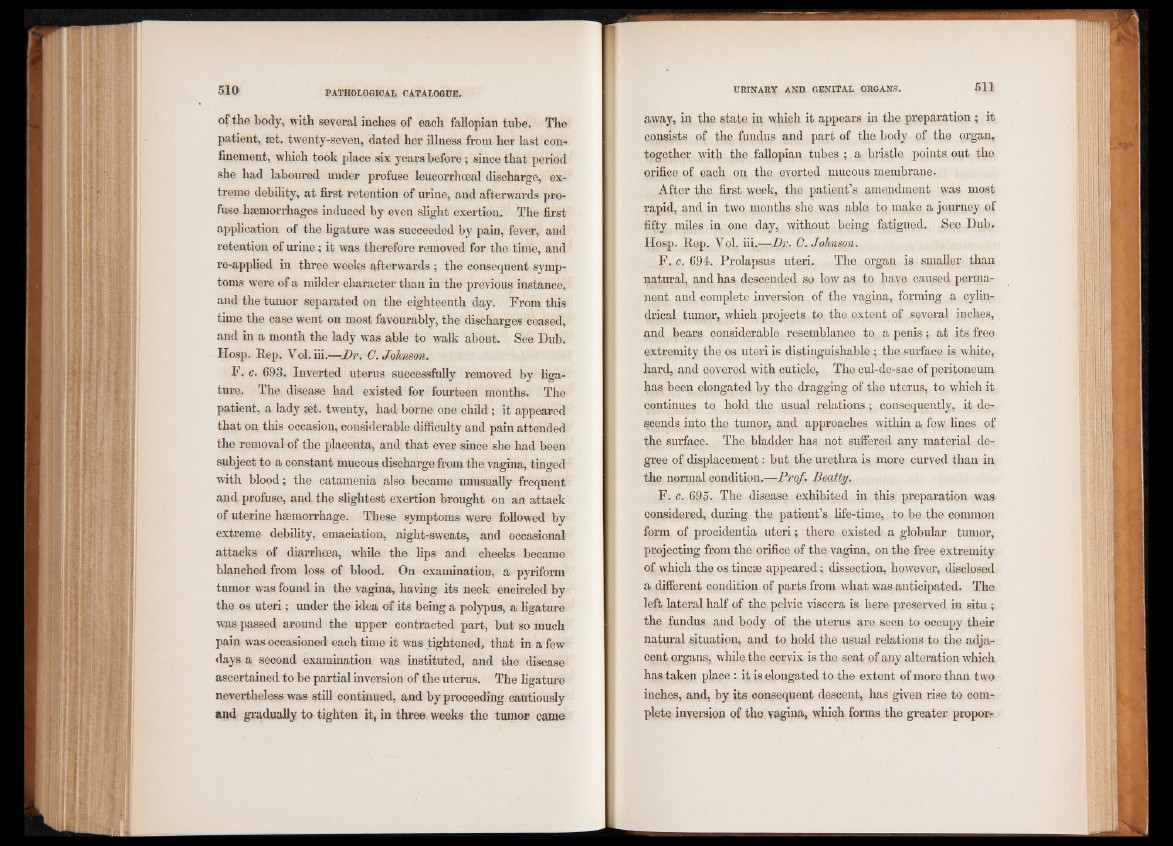
of the body, with several inches of each fallopian tube. The
patient, set. twenty-seven, dated her illness from her last confinement,
which took place six years before; since that period
she had laboured under profuse leucorrhceal discharge, extreme
debility, at first retention of urine, and afterwards profuse
haemorrhages induced by even slight exertion. The first
application of the ligature was succeeded by pain, fever, and
retention of urine; it was therefore removed for the time, and
re-applied in three weeks afterwards ; the consequent symptoms
were of a milder character than in the previous instance,
and the tumor separated on the eighteenth day. From this
time the case went on most favourably, the discharges ceased,
and in a month the lady was able to walk about. See Dub.
Hosp. Rep. Vol.iii.—Dr. C. Johnson.
F. c. 693. Inverted uterus successfully removed by ligature.
The disease had existed for fourteen months. The
patient, a lady set. twenty, had borne one child; it appeared
that on this occasion, considerable difficulty and pain attended
the removal of the placenta, and that ever since she had been
subject to a constant mucous discharge from the vagina, tinged
with blood; the catamenia also became unusually frequent
and profuse, and the slightest exertion brought on an attack
of uterine haemorrhage. These symptoms were followed by
extreme debility, emaciation, night-sweats, and occasional
attacks of diarrhoea, while the lips and cheeks became
blanched from loss of blood. On examination, a pyriform
tumor was found in the vagina, having its neck encircled by
the os uteri; under the idea of its being a polypus, a ligature
was passed around the upper contracted part, but so much
pain was occasioned each time it was tightened, that in a few
days a second examination was instituted, and the disease
ascertained to be partial inversion of the uterus. The ligature
nevertheless was still continued, and by proceeding cautiously
and gradually to tighten it, in three weeks the tumor came
away, in the state in which it appears in the preparation ; it
consists of the fundus and part of the body of the organ,
together with the fallopian tubes.; a bristle points out the
orifice of each on the everted mucous membrane.
After the first week, the patient’s amendment was most
rapid, and in two months she was able to make a journey of
fifty miles in one day, without being fatigued. See Dub.
Hosp. Rep. Vol. iii.—Dr. C. Johnson.
F. c. 694. Prolapsus uteri. The organ is smaller than
natural, and has descended so low as to have caused permanent
and complete inversion of the vagina, forming a cylindrical
tumor, which projects to the extent of several inches,
and bears considerable resemblance to a penis; at its free
extremity the os uteri is distinguishable ; the surface is white,
hard, and covered with cuticle, The cul-de-sac of peritoneum
has been elongated by the dragging of the uterus, to which it
continues to hold the usual relations; consequently, it descends
into the tumor, and approaches within a few lines of
the surface. The bladder has not suffered any material degree
of displacement: but the urethra is more curved than in
the normal condition.—Prof. Beatty.
F. c. 695. The disease exhibited in this preparation was
considered, during the patient’s life-time, to be the common
form of procidentia uteri; there existed a globular tumor,
projecting from the orifice of the vagina, on the free extremity
of which the os tincse appeared; dissection, however, disclosed
a different condition of parts from what was anticipated. The
left lateral half of the pelvic viscera is here preserved in situ ;
the fundus and body of the uterus are seen to occupy their
natural situation, and to hold the usual relations to the adjacent
organs, while the cervix is the seat of any alteration which
has taken place : it is elongated to the extent of more than two
inches, and, by its consequent descent, has given rise to complete
inversion of the vagina, which forms the greater propor